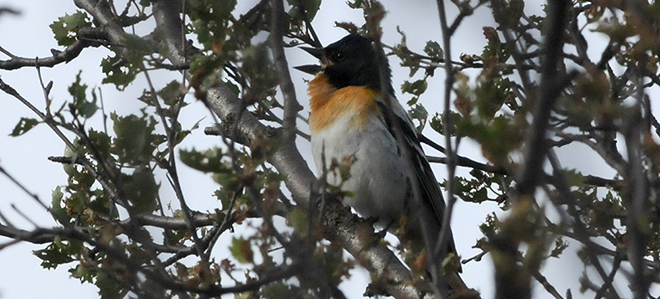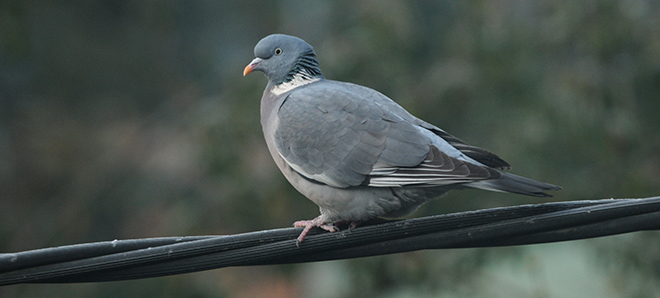Strong effects of climate change on common bird populations in both Europe and the USA
Scientists have shown for the first time that common bird populations are responding to climate change in a similar pronounced way in both Europe and the USA.
An international team of researchers led by Durham University, UK, found that populations of bird species expected to do well due to climate change had substantially outperformed those expected to do badly over a 30 year period from 1980 to 2010.
The research, conducted in collaboration with the RSPB and the United States Geological Survey (USGS), is published in the journal Science.
It is the first real demonstration that climate is having a similar, large-scale influence on the abundance of common birds in widely separated parts of the world, the researchers said.
Among the species showing pronounced effects of climate change are common woodland and garden birds such as the wren, in Europe, and the American robin in the USA.
The scientists characterised the climates favoured by different bird species to find out if recent changes in climate should have positively or negatively affected common breeding birds.
Using climate records for the period 1980 to 2010 they split species into two groups based on whether climate had been getting progressively better or worse for each species.
Using data from the same 30-year period for 145 common bird species in Europe and 380 common bird species in the USA, they contrasted average population trends of species in the two groups.
The team found a clear difference in the average population trends of bird species either advantaged or disadvantaged by climate change in both continents.
Populations of species predicted to have been favoured by changes in climate had, on average, substantially outperformed those expected to have been disadvantaged, the scientists said.
Populations of bee-eater and Cetti’s warbler, species with a southerly distribution in Europe, have increased in recent years, whilst more northerly distributed species such as willow tit and brambling have been declining in the same period.

Differences in population trends due to changes in climate can also be seen within the same species of bird across different geographical areas.
For example, in Europe, species such as the wren have been increasing in northern areas where winters are becoming milder, but declining in some southern countries where summers have been getting hotter and drier.
The UK population of the Dartford warbler, which used to be limited to Dorset, has increased eight-fold since the early 1980s, whilst declining in Spain, as predicted from changes in weather relative to the species’ preferences.
The American robin, a familiar species across much of continental USA, has declined in some southern states such as Mississippi and Louisiana, but increased in north-central states, such as the Dakotas.
These changes are consistent with changing climate suitability within those areas, the researchers said.
Other factors, such as the size of the birds, the habitats they live in and their migratory behaviour, all affect bird populations, but did not differ systematically between groups advantaged or disadvantaged by climate change.
Therefore, only climate change could explain the differences between average population trends in advantaged and disadvantaged groups, the researchers said.

The study’s lead authors, Dr Stephen Willis and Dr Philip Stephens, of Durham University’s School of Biological and Biomedical Sciences, said the findings showed there was a large-scale, consistent response by bird populations to climate change on two continents.
Dr Stephens said: “If there was no impact of climate change, you would expect the average population trend of species in the two groups to be the same, but the differences expose the fact that recent climate change has already favoured one set of species over another.”
Dr Willis added: “These findings represent a new climate impact indicator for biodiversity. The same approach could also be applied to species such as bees, butterflies and dragonflies, which are well monitored and highly susceptible to changes in climate.
“This helps us to understand where climate change is affecting populations, and to understand the causes of population changes of common birds that might also be affected by factors such as habitat loss and agricultural intensification.”
RSPB author Dr Richard Gregory said: “This study allows conservationists and decision makers to track the response of bird populations to ongoing climate change. Such indicators are an important guide to the scale of the impacts of global climate change on the natural world and a check on whether government policies are making a difference. The large quantity of data and wide geographical scope of this indicator make it one of the best currently available.”
USGS scientist Dr John Sauer said: “We are fortunate to have a rich trove of information in the North American Breeding Bird Survey, dating back to1961, and its European counterpart.
“Long term data sets are very valuable in ecological research, but it can be a challenge to figure out how best to use them to shed light on important conservation questions. This paper does that, and provides us with new indicators of change that we hope will be useful in bird conservation.”
The researchers said their methods could be applied to tropical or sub-tropical regions or the southern hemisphere, but bird monitoring has occurred in fewer places and for shorter periods in those regions. They hoped the research could lead to expanded monitoring in these areas.
The study was part-funded by the RSPB, the European Environment Agency, the European Commission and Durham University’s Grevillea Trust. The underlying data collection and analyses were funded through a wide variety of sources.
The study was only made possible by the dedication of thousands of volunteers who survey birds on the same survey plots using the same rigorous methods every year. This huge effort is co-ordinated by the European Bird Census Council (EBCC) in Europe and by USGS in the USA.
Source information
Consistent response of bird populations to climate change on two continents, Stephens, P, et al, published in Science.
More information
Academy Research Fellow Aleksi Lehikoinen
Finnish Museum of Natural History LUOMUS
University of Helsinki
phone: +358 50 318 2340
aleksi.lehikoinen@helsinki.fi